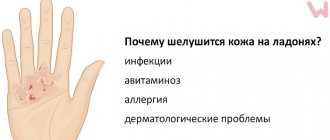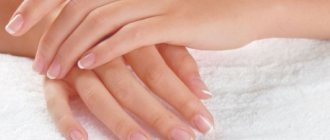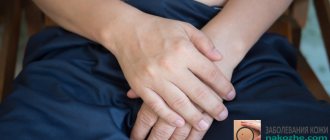Changes in the quality of the skin are always associated with certain reasons, both external and internal. It is important to determine in time what exactly underlies negative changes. Some areas of the epidermis are more susceptible to this effect than others, and therefore suffer first. For example, most often you have to deal with peeling in the elbows and knees. This is understandable, because these are the parts of the body that face the maximum surface load. In addition, the condition of the skin is affected by internal processes and imbalances in the body. Peeling skin on the knees can be caused by:
- hormonal disorders,
- external irritation,
- dehydration,
- lack of vitamins and microelements,
- lack of vegetable fats in the body,
- endocrine diseases,
- dermatological pathologies (red spots on the skin, rashes, itching), etc.
If the peeling is local in nature and covers only the knee area, and has the appearance of dry skin without signs of swelling and papular formations, perhaps the problem lies in external irritation. Then you can eliminate the unpleasant symptom with the help of additional, and most importantly, proper care. Thick crusts and plaques, cracks and atrophied areas with loss of sensitivity indicate that the underlying lesion is a disease that requires treatment.
The importance of proper care
The skin in the area of the knees and elbows needs to be looked after no less, and sometimes even more so. Especially if these areas are systematically negatively impacted. For example, the skin of the knees often suffers from constant contact with clothing, synthetic fabrics, nylon tights, etc. Sometimes the kneecap is subjected to mechanical pressure, friction, or traumatic effects. Excess ultraviolet radiation can also aggravate the condition of the epidermis.
If the body lacks vitamins and vegetable fats, the entire skin suffers, but it is in the area of the knees and elbows that its condition is especially deplorable. If the skin on your knees peels, you need to take the following measures:
- add vegetable oils to the diet, especially rich in vitamins A and E (olive, flaxseed, sesame),
- maintain a drinking regime (daily water consumption should be about 1.5 liters),
- provide additional care to the skin in the knee area - exfoliate, apply an emollient with a moisturizing effect (oil, cream),
- minimize skin contact with rough and/or synthetic fabrics.
Read also: Dry and cracked skin on the hands: photos, diseases, treatment
It is also useful to periodically take baths with softening oils and herbal infusions, which have a positive effect on the condition of the skin. Before going outside in the hot season, you should apply protective products to your body to protect from exposure to sunlight. If, despite all the measures taken, peeling on the knees does not stop, you should consult a doctor to determine the cause of this phenomenon and determine further treatment.
Plantar type of psoriasis
Psoriasis on the legs may first appear on the soles of the feet. In this case, the following may appear on the feet:
- typical rashes in the form of papules at the initial stage; over time, they merge with each other to form large plaques; this is a typical form, it proceeds in the same way as in other areas;
- the skin of the soles becomes covered with flaky itchy spots, it is dry, thickened (psoriatic calluses), and covered with cracks; this is the so-called horny form of the disease; cracks in the affected areas of the skin of the feet are very painful, which creates great problems when wearing shoes;
- pustular (purulent) rashes appear on the soles, merging into large lakes - this is Barber's pustular psoriasis; after the ulcers dry out, brown crusts form, at the site of which red spots remain; the toes may also be affected;
The skin on the knees is peeling
Treatment methods for psoriasis on the legs
Treating psoriasis on the legs is a difficult task. Psoriasis should be treated comprehensively. It is recommended for patients with psoriasis on the legs:
- optimization of the daily routine, combining an active lifestyle with rest and healthy sleep at night;
- avoiding smoking and drinking any types of alcoholic beverages;
- eliminating stress;
- avoiding high physical activity with associated sweating;
- exclusion of contact (wrestling, boxing) sports;
- proper regular nutrition; Salty, sour, spicy foods, as well as vegetables containing essential oils that irritate the skin are not recommended; limited consumption of meat, consumption of large quantities of vegetables and fruits; drink plenty of fluids: drink plus 6 glasses per day added to the rest of the liquid;
- wearing shoes made of genuine leather or textiles with low heels that do not compress the feet;
- when playing sports, try not to injure the knee area;
- timely elimination of fungal, bacterial and viral infections of the feet;
- regular treatment under the supervision of a physician of all chronic pathologies, elimination of foci of infection;
- daily foot washing using hypoallergenic gels or baby soap; cutting toenails; after this, a moisturizing hypoallergenic cream should be applied to the skin;
- wearing socks made of cotton fabrics in light colors (dyes can provoke an exacerbation of psoriasis).
Red spots on the skin after stress
Diagnosis of skin diseases
Drug therapy
The choice of medications depends on the nature of psoriasis, the stage of the disease, its course and spread, the age of the patient, and the presence or absence of concomitant pathology. The goal of drug therapy is to eliminate the symptoms of the disease, which leads to an improvement in the patient’s quality of life. With the right approach to the treatment process, you can constantly maintain psoriasis in a state of remission, but you cannot guarantee its complete cure.
Preference is given to step-by-step external treatment with alternation of modern topical drugs belonging to different groups. For severe and widespread forms of psoriasis of the legs, individually selected combination treatment with general and local drugs is prescribed.
Local treatment
For local therapy the following are used:
- Ointments, creams, solutions based on glucocorticoid hormones (GCS). These remedies are widely used in the treatment of all forms of psoriasis of the legs. They perfectly relieve inflammation, swelling, itching, suppress proliferation (rapid division) of epithelial cells, inhibiting peeling. Combination ointments are also used, which, in addition to GCS, contain keratolytics - substances that dissolve keratinized epithelial cells and ensure rapid penetration of GCS to the cells (Diprosalik). But if the rash spreads quickly and aggressively, keratolytics can irritate the skin, so they are used with caution.
- Ointments, creams and lotions based on a synthetic analogue of vitamin D (Davonex). The drug actively affects the metabolism in cells, suppressing processes that contribute to the occurrence of disorders. Recently, a drug has been produced that, in addition to a synthetic analogue of vitamin D, includes an active substance from the GCS group (Daivobet). Modern step-by-step therapy includes the use of Daivonex first (in the early stages), and then Daivobet (during follow-up treatment).
- Keratolytic agents (salicylic acid) - soften rough layers of dead cells, improve access to cells of other drugs. Suitable for the treatment of horny psoriasis of the soles.
- Ointments and pastes based on activated zinc - have an anti-inflammatory and antiseptic effect, well suited for eliminating psoriasis of the feet and atypical forms.
- Ointments, creams, gels based on tar - have an anti-inflammatory, absorbable, antiseptic, analgesic effect. Suitable for eliminating the symptoms of plaque psoriasis on the feet in the stationary stage.
General treatment
General therapy is prescribed for a widespread process, as well as for the development of severe pustular forms of the disease, when local treatment is ineffective. Patients are prescribed:
- In order to eliminate intoxication and suppress allergies:
- calcium supplements, hemodez;
- antihistamines – Suprastin;
- In order to suppress the rapid proliferation (division) of cells in the lesions:
- drugs based on corticosteroids - administered in the form of infusions, injections or taken orally;
- cytostatics (Metoltrexate);
- aromatic retinoids (Acitretin).
- In order to suppress the excessive sensitivity of the immune system - immunosuppressants (Cyclosporin-A);
- In order to eliminate the symptoms of inflammation and tissue swelling, itching and pain:
- drugs based on corticosteroids;
- biological drugs (Remicade) - contain proteins that recognize and neutralize substances that support inflammation.
- In order to eliminate neuropsychic symptoms:
- sedatives (sedatives (Novopassit).
What and how to treat knees
Relieving burning and pain is only the first step towards restoring health. More precisely, helping the body get rid of unpleasant sensations. However, often this has nothing to do with the treatment of the disease itself. When the doctor knows that fever in the knees is a consequence of one or another pathology, a full course of treatment is prescribed, which may include:
- massage;
- physiotherapeutic procedures;
- therapeutic exercises;
- use of medications.
If we are talking about serious damage to the knee joint caused by injuries or diseases of the musculoskeletal system, surgical intervention is indicated. Most often, this is endoprosthetics - an operation in which a joint is partially or completely replaced with a prosthesis. Modern technologies make it possible, with the help of such an operation, to completely restore the mobility of the lower extremities and return patients to a full life.
Surgical intervention with prosthetics is also indicated in the case of cancer, when bones and joints are damaged as a result of metastases. Just a few decades ago, with such a diagnosis, the only way out of the situation was amputation of limbs.
Today, joint replacement is a simple, effective and minimally invasive way to solve problems for people who are faced with cancer.
Causes of a pathological nature
Unfortunately, not all problems can be solved with moisturizer. Sometimes peeling is a consequence of diseases of internal organs and their systems, as well as a sign of skin diseases, parasitic activity, etc. Possible reasons for this phenomenon include:
- disorders of the adrenal glands;
- thyroid diseases;
- diabetes;
- anemia;
- avitaminosis;
- bacterial and fungal infections;
- dermatological diseases.
The actual cause can only be determined through professional diagnostics. However, based on the external signs and characteristics of peeling, one can make assumptions regarding its nature and methods of treatment. For example, if the skin on the knee of the right leg is peeling, but its condition on the left has not changed, then the reason most likely lies not in internal causes, but in a directed effect.
If the skin on one knee was damaged (even slightly) and was not treated with an antiseptic in time, pathogenic microorganisms could penetrate into the resulting wound. In this case, an inflammatory process will develop here, accompanied by peeling. Fungal activity can manifest itself in a similar way. If the fungus gets directly onto the skin of the knee and becomes active there, then the primary focus will be formed in this area. However, if left untreated, it will soon spread to other surfaces.
With vitamin deficiencies and hormonal disorders, as a rule, the entire skin suffers. The skin may lose elasticity, and small keratinized scales appear on its surface. But on the knees and elbows it becomes especially dry. To solve this problem, it is necessary to take measures to normalize metabolic processes and hormonal levels, while at the same time strengthening measures to care for the skin in general and the surface of the knees in particular.











